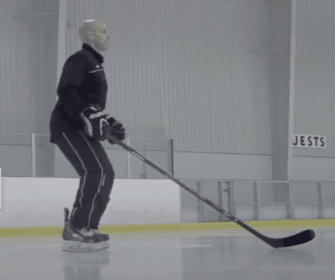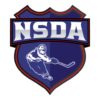What is the Hockey Player Position Or Stance and Why is it Important?
The Hockey Player Position or Stance is the standard athletic position that all hockey movements are based upon. Maintaining or recovering back to the position as quickly as possible is the key to being efficient in all of your hockey skills. It is the position that gives the body the optimal centre of gravity for hockey. Therefore, it is important to help a player control their movements and balance.
What is the Centre of Gravity?
According to the Encyclopaedia Britannica, the Centre of Gravity of an object is “an imaginary point in a body of matter where, for convenience in certain calculations, the total weight of the body may be thought to be concentrated. The concept is sometimes useful in predicting the behaviour of a moving body when it is acted on by gravity.” In simplified terms, the body’s centre of gravity is the balance point.
How to Get into the Position

Standing in the Hockey Player Position means your head is over your knees, and your knees are over your toes. Your head should be up, not looking at your feet. You should be leaning slightly forward, but your back should be straight, not hunched over. Lastly, your knees should be shoulder width apart and bent, with your weight on the balls of your feet. Proper knee bend is important to add stability, power, and length to a player’s stride. You should be able to draw an imaginary straight line from your shoulders through your knees and toes.
How to Correct a Player Standing too Upright
There are a few common inefficiencies coaches will run into with the Hockey Player Position. For example, players start skating and stop bending their knees while lifting their shoulders to stand up in a rigid stance. When players get “too tall” in their stance, they lose a lot of their power.
One way to show players why this is inefficient is to have the player stand stationary on the ice. Get them to stand tall and see how far they can push their leg back before their blade loses contact with the ice. Now get them to stand in the proper position and repeat the same movement. They will gain significant length to their stride when they have their knees bent and have more balance when they lean slightly forward.
How to Correct a Player Hunched Too Far Forward
Another common inefficiency in the stance is having the player hunched too far forward, with their shoulders past their skates. This is especially common when players are skating backward as they feel like they may fall back and are trying to compensate. What the player doesn’t understand is that this actually makes them less stable because they do not have an optimal centre of gravity in a hunched-over position.
You can address this with a player by having them stand stationary on the ice. Get them to stand in the hunched-over position and give them a gentle nudge from behind. As a result, the player will become pretty unstable and fall slightly forward. Now have the player stand in the correct position and give them a gentle nudge forward and backward. Consequently, the player’s centre of gravity is greatly improved in the proper stance and they will find it a lot easier to maintain their balance.
Want to connect and share ideas with other hockey coaches from around the world? Join our Minor Hockey Coaches Group on Facebook, which has coaches from Canada, the United States, Europe and even Australia.
Are you looking for help to practice more of your skills? Check out the rest of our videos here.
